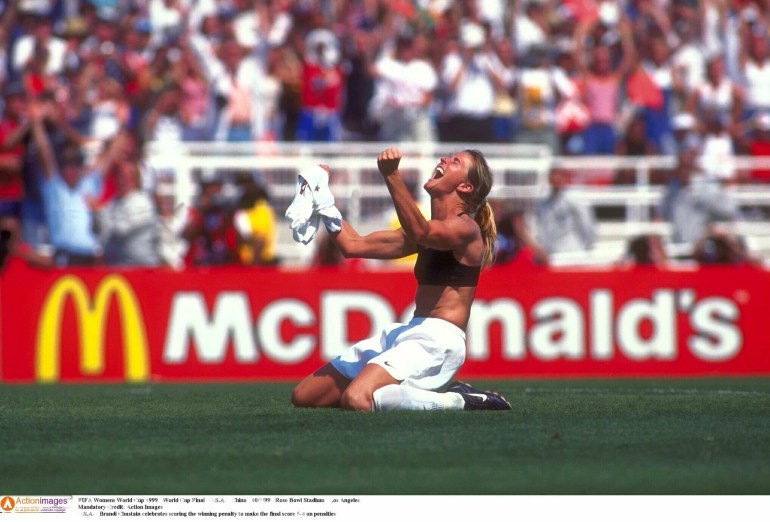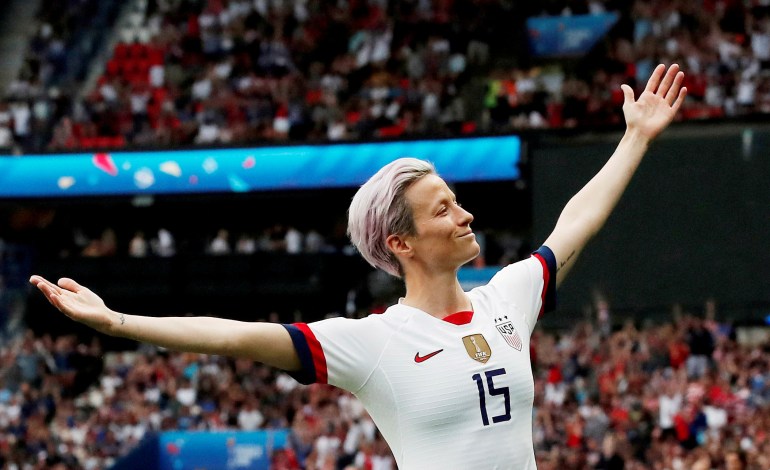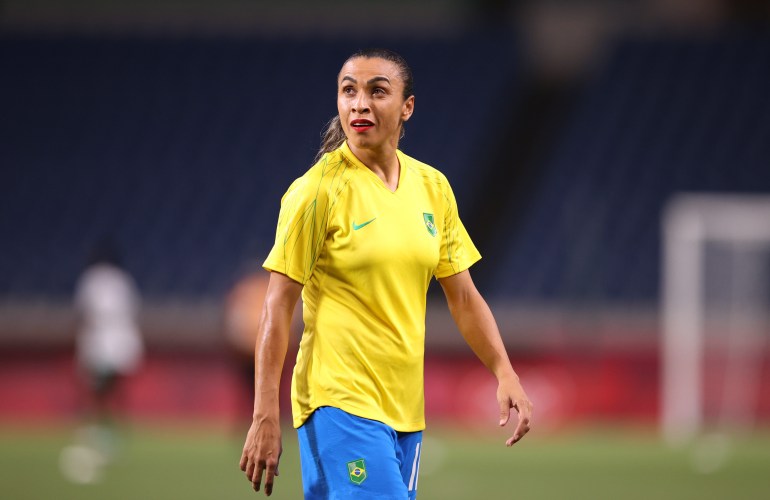It has never been done before.
But the United States women’s national football team (USWNT) is trying to make history by becoming the first side in the sport’s history – among men or women – to win the World Cup three times in a row.
And so, all eyes are on Team USA as the Women’s World Cup kicks off in New Zealand and Australia on July 20.
The USWNT have won four out of eight World Cups since the tournament’s inception in 1991. Last time around, in France, the US lifted the trophy without losing a single game, only conceding three goals in seven matches. The team also set the record for the largest margin of victory in a 13-0 win over Thailand in 2019.
But straddled by injuries and undergoing a generational shift, the US team may not be as dominant as it once was. And with the women’s game growing in quality and popularity across the world, other nations are emerging as powerhouses and threatening the US’s hegemony as the strongest squad in the sport.
England, Spain, France and Germany, which are seeing an explosion of the women’s game at the club level, will represent a serious challenge for the US. The Netherlands, Sweden, Japan, Olympic champions Canada and hosts Australia will be looking to make a mark on the tournament. Many analysts are also expecting Brazil to be the dark horse of the World Cup.
So can any of these teams dethrone the US? What are the reigning champions’ strengths and weaknesses? And who will be their most potent challengers?
The short answer: The USWNT are still the team to beat. The bookkeepers have them as the clear favourites. Their winning mentality coupled with unquestionable quality has made them FIFA’s top-ranked team. But they are not automatically champions-in-waiting as they aim to achieve something no one else has done. Their injury crisis and the rise of several other teams mean it would not be a major surprise if the USA loses its title.
How did the US become dominant?
Men’s football – or soccer as Americans call the sport – is not the most popular game in the US. But it’s a top women’s sport. That dominance within the US has also been reflected in the women’s team’s international performances.
In eight World Cups since the first one in 1991, the US has reached the semi-final in every tournament, never finishing below third place.
Some of the earliest professional women’s football leagues were established in the US, and the country’s current top flight – the National Women’s Soccer League (NWSL) – is among the most popular and prestigious in the world.
One of the main reasons beyond this success, experts say, is the game’s popularity at the college level. In a country where male athletes are generally drawn to basketball, American football and baseball, soccer is the go-to sport for girls and young women.
With an expansive country of 330 million people and robust academies and college athletic programmes, the set-up produces a talent “pipeline” that ensures success, said Bekki Morgan, a freelance writer who covers women’s football.
“Women’s football has just been able to flourish, and almost every girl in the country plays soccer as a child,” Morgan said. “So, there’s just this level of interest.”
The USWNT has rewarded that interest with trophies – four World Cups and four Olympic gold medals – as well as many memorable, “where were you when” moments.
After scoring the last penalty in front of 90,000 attendees near Los Angeles in a penalty shootout in the 1999 World Cup final against China, Brandi Chastain took off her shirt and dropped to her knees, creating a defining moment in the history of the sport.

Chastain became one of the legends of her generation along with the likes of Kristine Lilly and Mia Hamm. Stars, including Carli Lloyd, Hope Solo, Megan Rapinoe and Alex Morgan have followed in their footsteps. And with many of those players retiring, great prospects in their early 20s and late teens are emerging.
A key factor behind that talent production factory has been Title IX, a 1972 legislation that prohibited sex-based discrimination by educational institutions receiving federal funding, including in athletics programmes, experts say.
To comply with the law, schools have to grant equal sporting opportunities to female students. The regulations have boosted women’s sport over the past decades.
“Title IX really helped a lot in terms of keeping women in sports. You start out playing young; you can continue to play, and you actually have a path in college,” said Andre Carlisle, co-host of the Diaspora United podcast, which focuses on Black women in football.
“So, college softball is massive. Volleyball is getting very big. Soccer has been our thing. It’s been the main thing.”
Jennifer Gruskoff, editor-in-chief of Girls Soccer Network, which reports on women’s football at all levels, said the relative lack of popularity of men’s football in the US created an opportunity for women to take the lead in the sport early on.
“Because there are so many popular men’s sports here in the United States, I think that there was an opening and that girls and women started to play the sport,” Gruskoff told Al Jazeera.
“They sort of claimed it as their own in their own way. And they started to pay a lot of attention to it and become quite good at it [when] other countries were still focusing on their men’s game.”

‘The world is catching up’
Yet, while the US may have had a headstart in developing and professionalising women’s football, the rest of the world is now increasingly also focusing on the women’s game.
“The world is catching up” is a common phrase that US commentators are deploying when talking about Team USA’s chances in Australia and New Zealand.
One example is Europe, where top football clubs have been increasingly promoting their women’s sides, which in turn has drawn supporters in the tens of thousands to their games.
Women’s football has also been gaining popularity at the national team level.
The Lionesses of England drew a sold-out attendance of nearly 90,000 fans to Wembley Stadium in London for the 2022 Euro final when they claimed the continental trophy – something their male counterparts failed to do at the same venue a year earlier.
And it’s not just Europe. Women’s football is picking up interest across the world. As Carlisle, who is a self-described “incessant women’s soccer tweeter”, put it: Football is a universal sport with global appeal, so it wouldn’t make sense to leave half of humanity out of it.
“It’s the most popular sport, and it’s always kind of been silly to assume that it wouldn’t be popular just because women are playing it. So now, we’re seeing that we’re kind of getting over that hump,” he told Al Jazeera.
Star USA striker Alex Morgan appeared to acknowledge that the gap is closing at the top ahead of the World Cup.
“By far it’s going to be the most competitive World Cup,” she was quoted as saying by the Los Angeles Times newspaper. “It’s just getting increasingly competitive.”
‘Winning mentality’
Despite the tough competition expected in Australia and New Zealand, many commentators are still favouring the USA to win it.
That’s because sometimes winning begets winning.
“The expectations are very clear: We have to win it all,” US team coach Vlatko Andonovski told ESPN last month.
“The expectations are to win every game. And it’s not something that we even talk about. This is the type of mentality that has been established a long time ago, way before I was a coach or any of these players played on the team.”
The team also enjoys a wealth of talent, especially in the attacking department – despite injuries to leading goalscorer Mallory Swanson and star player Catarina Macario.
Upfront, accomplished veteran Morgan is surrounded by many potent options, including the prolific Sophia Smith and emerging talents Trinity Rodman and Alyssa Thompson. Playing in her first World Cup at age 30, Lynn Williams is also a proven goalscorer.
At 38, legend Megan Rapinoe is expected to play a limited role at the tournament, but she still can be influential with her experience on the pitch and in the locker room.
“The fact that, even with these major injuries, the US still has players of this calibre to lead their attack shows that it is absolutely their biggest strength,” said Bekki Morgan, the journalist.
“They haven’t necessarily been connecting as well as people had hoped maybe in the last six months. But still, if they can just click – and the US has a history of just clicking when tournament time comes – they can absolutely pull it together and be really dangerous.”
For her part, Gruskoff stressed the team’s “winning mentality”, which she said gives the USWNT the edge.
“We have incredible colleges and youth programmes that build up these players to get to the point where they are, but there’s this X factor – which is the winning mentality that has been tested amongst generations and proven successful,” she said.
What are the weaknesses?
That expectation to win is about to be tested in Australia and New Zealand, and other teams might be smelling blood.
In defence, midfield and attack, the USWNT has lost key players to injuries and may struggle with depth and lack of experience. The upcoming World Cup will be the first for 14 of the 23 players named by Andonovski.
The foot injury to team captain and leading centreback Becky Sauerbrunn, which ruled her out of the tournament, dealt a double blow to the USWNT because of both the quality and leadership she offers.
The defence may prove to be Team USA’s Achilles heel, experts say. Alana Cook, 26, and Naomi Girma, 23, will deputise for Sauerbrunn alongside 29-year-old Emily Sonnett. While all three defenders are capable, experience is especially crucial in the centreback position.
“They just don’t have the history and the experience that Becky Sauerbrunn had,” Morgan said. “We’re going in with three-quarters of what is likely to be our starting backline never having experienced a World Cup. So that’s a pretty big deal.”
In the sendoff game against Wales, Andonovski’s starting back-four also had Emily Fox – a fullback who too will be playing in her inaugural World Cup.
“The entire backline – fullbacks and the centrebacks are good – but they don’t have a lot of depth there,” said Carlisle. “When players do have to come in as depth, that’s where you’re going to see a drop-off, and you’re also going to see incompatibility because they’re just unfamiliar with each other in certain positions.”
Beyond the immediate issues, cracks have shown in the team’s performance in recent years. The USA women lost to England and Spain last year, and in 2021, they crashed out of the semi-final of the Olympic Games in Japan after a 1-0 loss to eventual champions Canada.

Who can take the trophy?
England, Germany, France and Spain are widely expected to be the US’s main rivals in the World Cup, but like the defending champions, these four teams are also missing key players to injury.
Both Gruskoff and Bekki Morgan predicted that Brazil would make a deep run into the tournament and challenge for the title. The World Cup will be veteran superstar Marta’s sixth and likely final tournament. Winning the trophy for her would be akin to the fairytale success of Lionel Messi’s Argentina in the 2022 World Cup in Qatar.
With star Brazilian players who play in the NWSL – including Debinha and Ary Borges – Morgan said the South American side “are poised to do very well”.
For Carlisle, the competition is wide open and all the favourites have a realistic chance of winning it – or losing it. “Pretty much every big team has a question mark,” he said.
Sumber: www.aljazeera.com
 Skip to content
Skip to content

